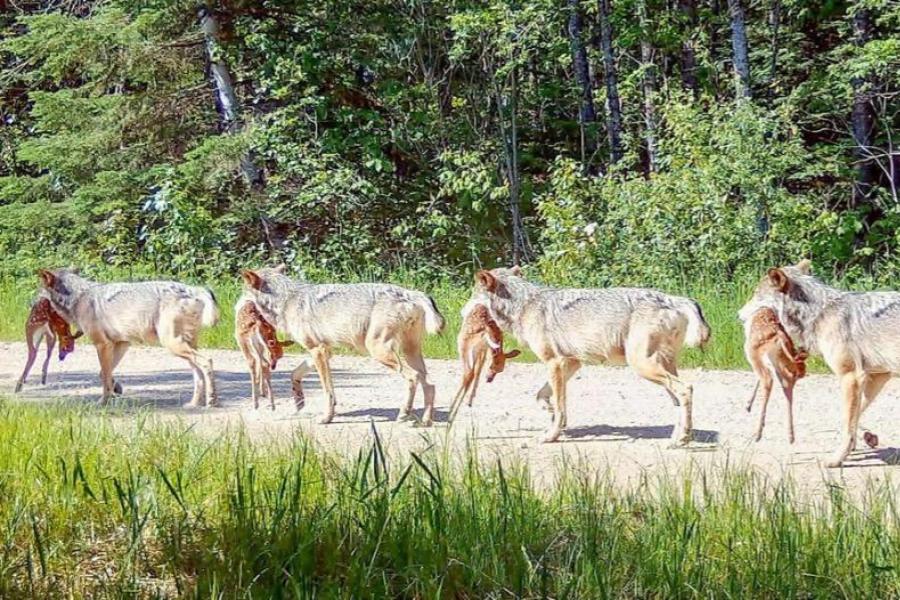
MINNEAPOLIS/ST. PAUL (10/30/2023) — New research from the University of Minnesota’s Voyageurs Wolf Project found that human activities in northern Minnesota — logging, road and trail creation, and infrastructure development — have profoundly impacted where wolves hunt and kill deer fawns. By altering forest ecosystems, humans have created an environment that possibly favors the predators.
This research, recently published in Ecological Applications, is a collaboration between the University of Minnesota, Northern Michigan University, the University of Manitoba, Voyageurs National Park, and the Voyageurs Wolf Project. The Voyageurs Wolf Project is funded, in part, by the Minnesota Environment and Natural Resources Trust Fund as recommended by the Legislative-Citizen Commission on Minnesota Resources (LCCMR).
“The premise is really quite simple: human activities change where deer are on the landscape, and wolves go where the deer are,” said co-lead author Thomas Gable, a postdoctoral researcher at the University of Minnesota and project lead for the Voyageurs Wolf Project.
The researchers found:
- Wolves disproportionately hunt and kill deer fawns around recently logged areas — those logged within the past five years. This is likely because clear-cut forests provide dense stands of young saplings, supplying prime food for deer and excellent hiding spots for newborn fawns. Wolves seem to know these recently-logged areas are good hunting spots, turning the nursery grounds into risky areas for deer fawns during summer.
- More than expected, wolves tend to kill deer fawns closer to human infrastructure, like cabins, year-round residences and barns. This is likely in part due to the fact that supplemental feeding of deer by people is common in the region, and this likely congregates deer near human-developed areas. The high concentration of deer near human development, in turn, attracts wolves to areas near people.
- Wolves preferentially hunted fawns from linear features — roads, powerlines, ATV/UTV trails, and hunting lanes — and disproportionately killed fawns closer to these features than would be expected. This was unsurprising to the research team, as wolves face the same general issues that people do when traveling in the woods, and just like humans, wolves often prefer to travel on linear corridors than through dense forest.
“When we put all of the pieces together, it is pretty clear that the cumulative effects of all major aspects of human activity in the Northwoods — logging, infrastructure development, and road and trail development — have fundamentally changed where and how wolves hunt deer fawns here,” said Sean Johnson-Bice, a Ph.D. candidate from the University of Manitoba and co-lead author of the study. “The rules of this predator-prey game change when people alter ecosystems, and it’s possible we have created conditions that may have tipped the scales in the predators’ favor.”
Future research is needed to understand whether human activities have simply influenced where wolves end up killing deer fawns or if human activities have actually increased wolf hunting efficiency of deer. The team is exploring various approaches to examining this question.
About the College of Food, Agricultural and Natural Resource Sciences
The University of Minnesota’s College of Food, Agricultural and Natural Resource Sciences (CFANS) strives to inspire minds, nourish people, and sustainably enhance the natural environment. CFANS has a legacy of innovation, bringing discoveries to life through science and educating the next generation of leaders. Every day, students, faculty, and researchers use science to address the grand challenges of the world today and in the future. CFANS offers an unparalleled expanse of experiential learning opportunities for students and the community, with 12 academic departments, 10 research and outreach centers across the state, the Minnesota Landscape Arboretum, the Bell Museum of Natural History, and dozens of interdisciplinary centers. Learn more at cfans.umn.edu.
- Categories:
- Agriculture and Environment
- Animals





